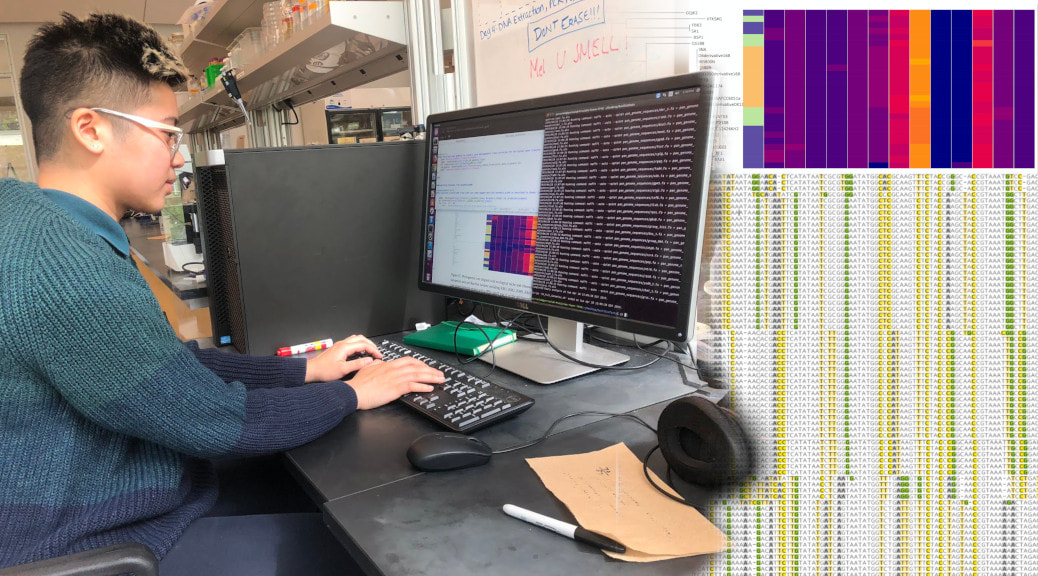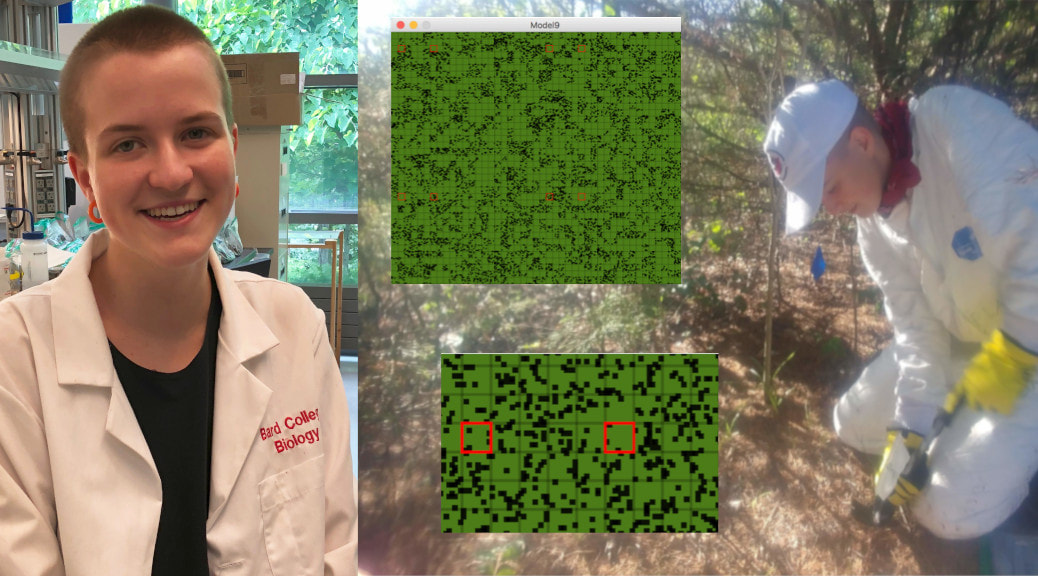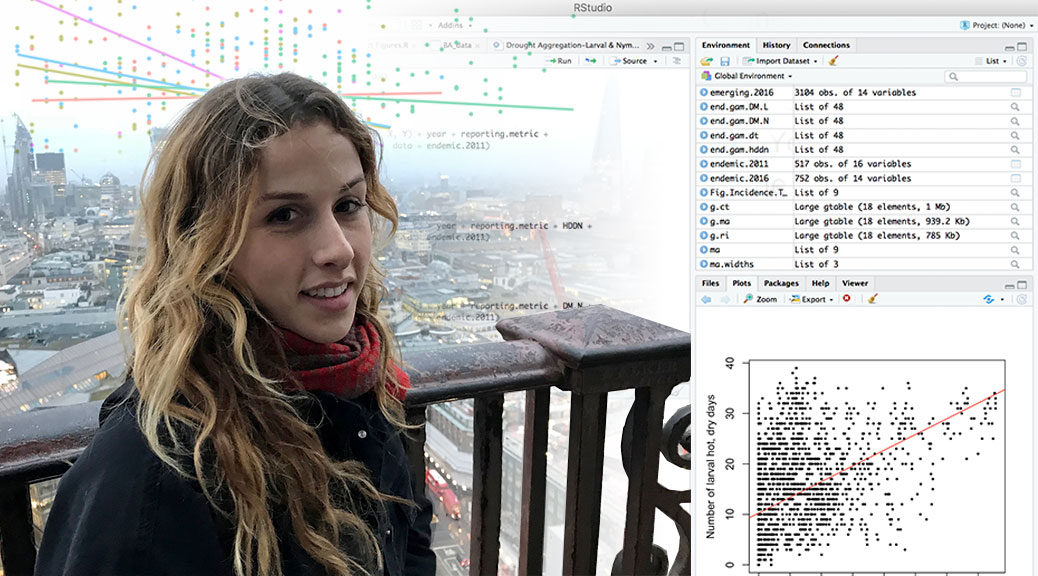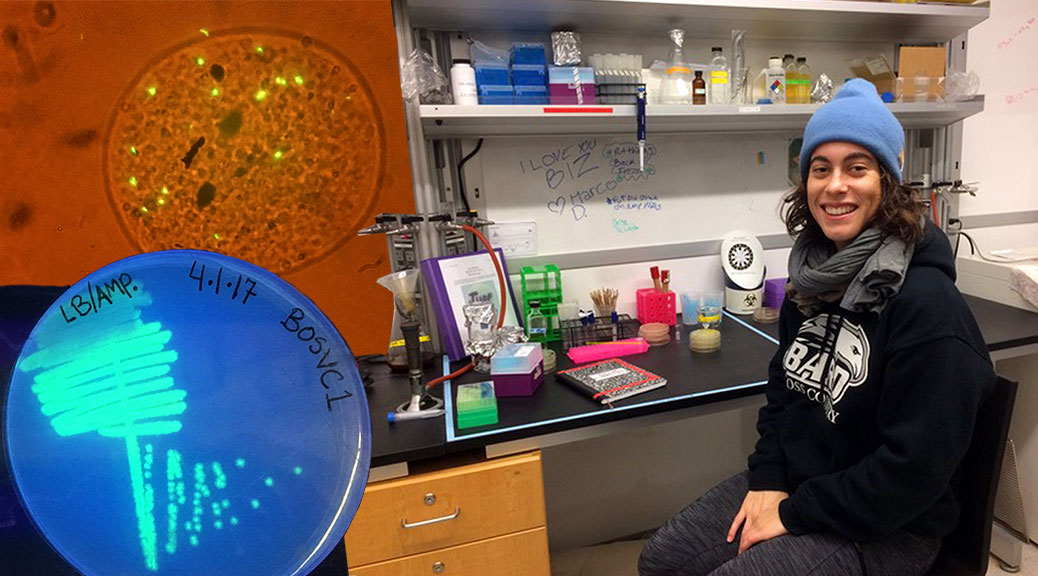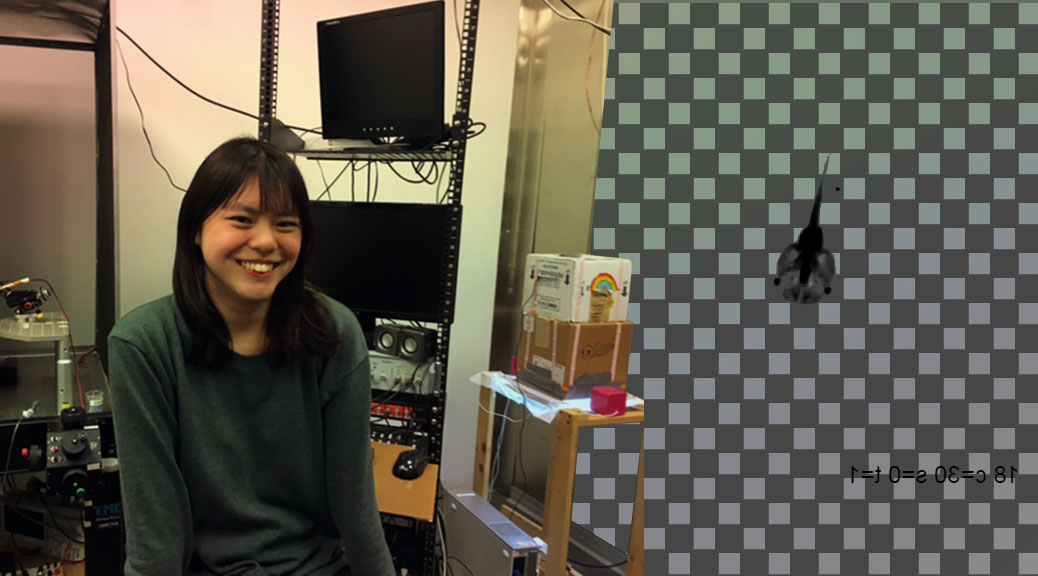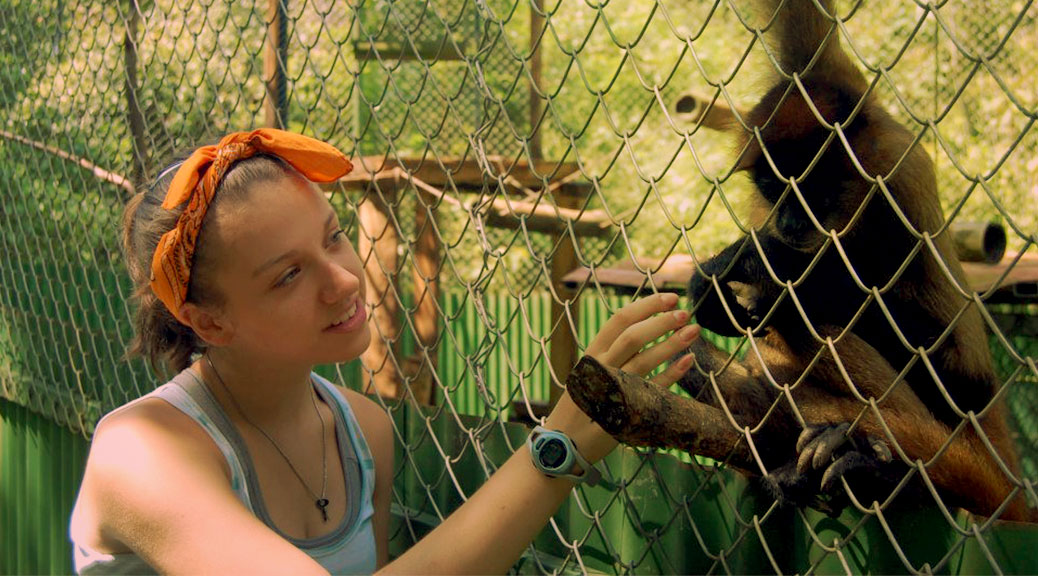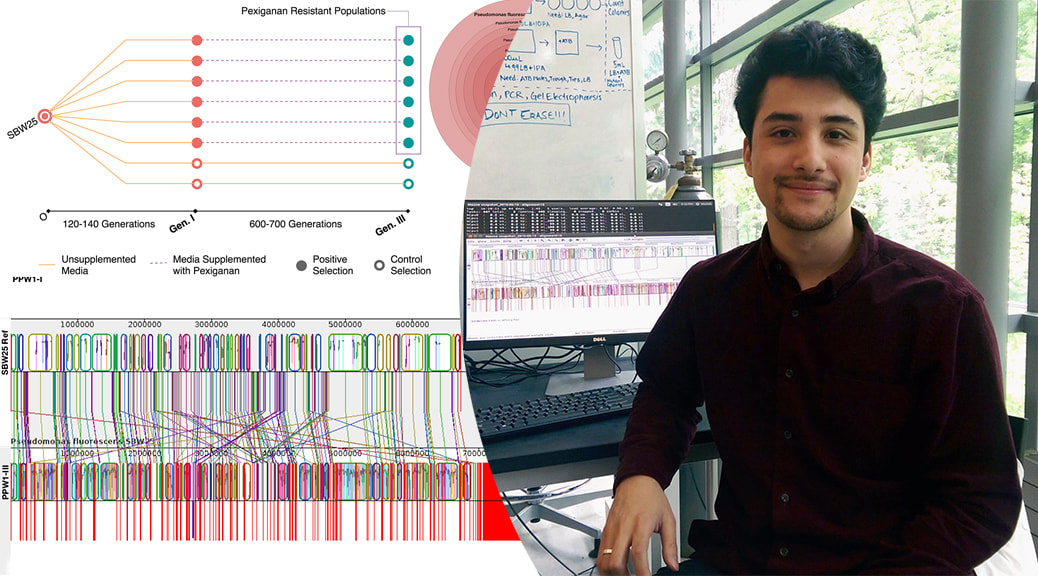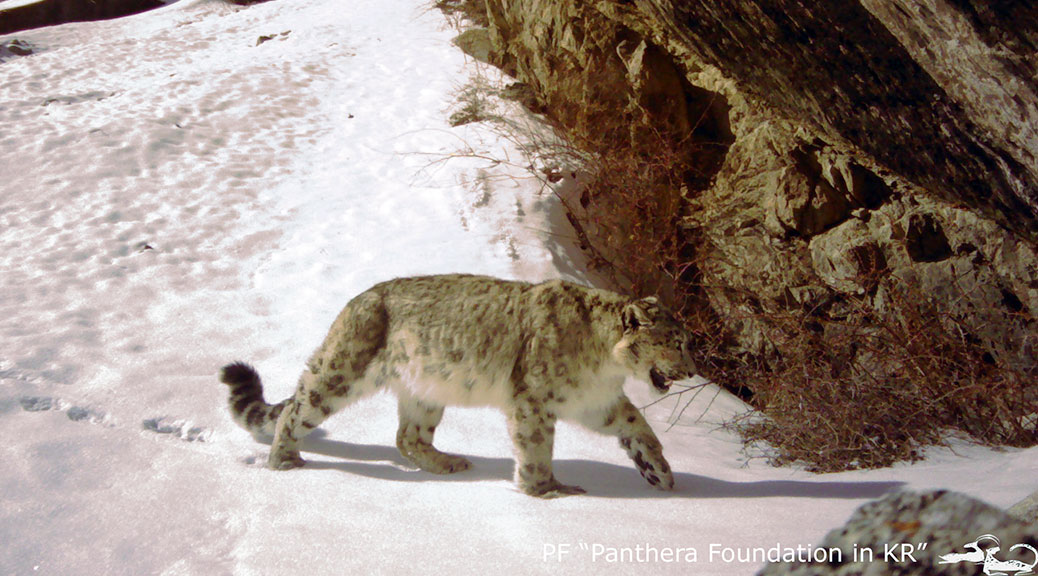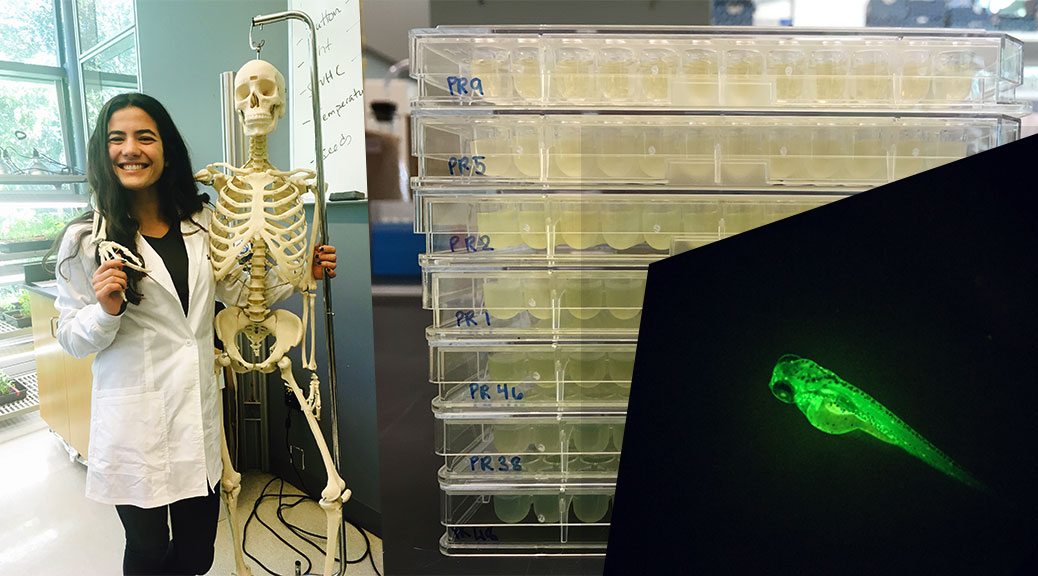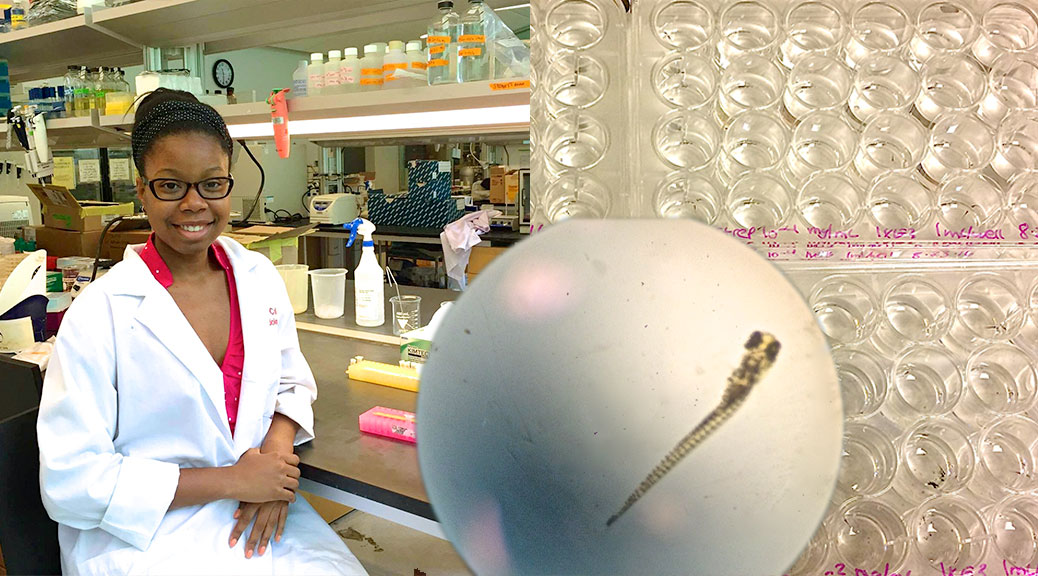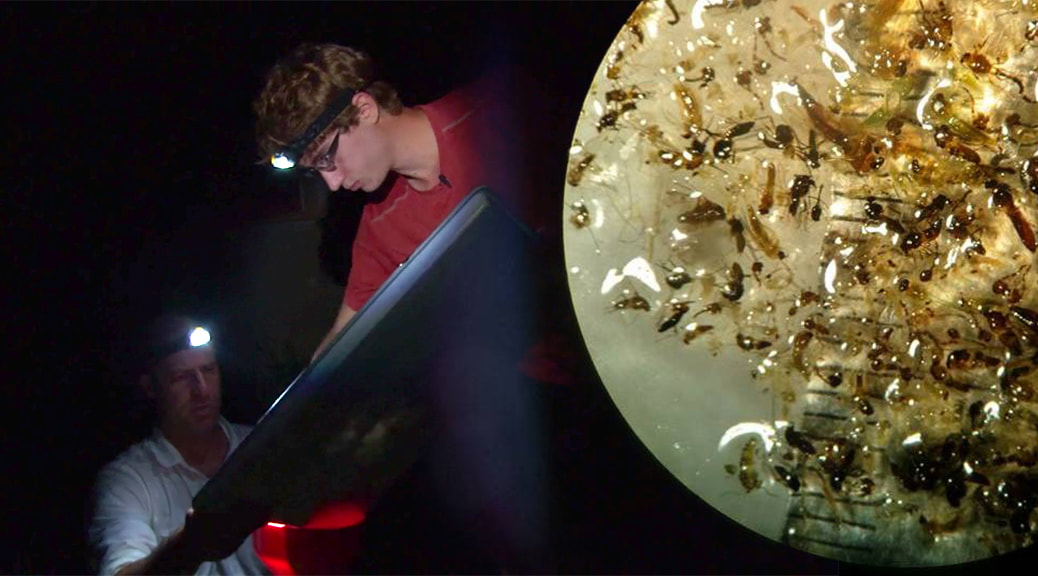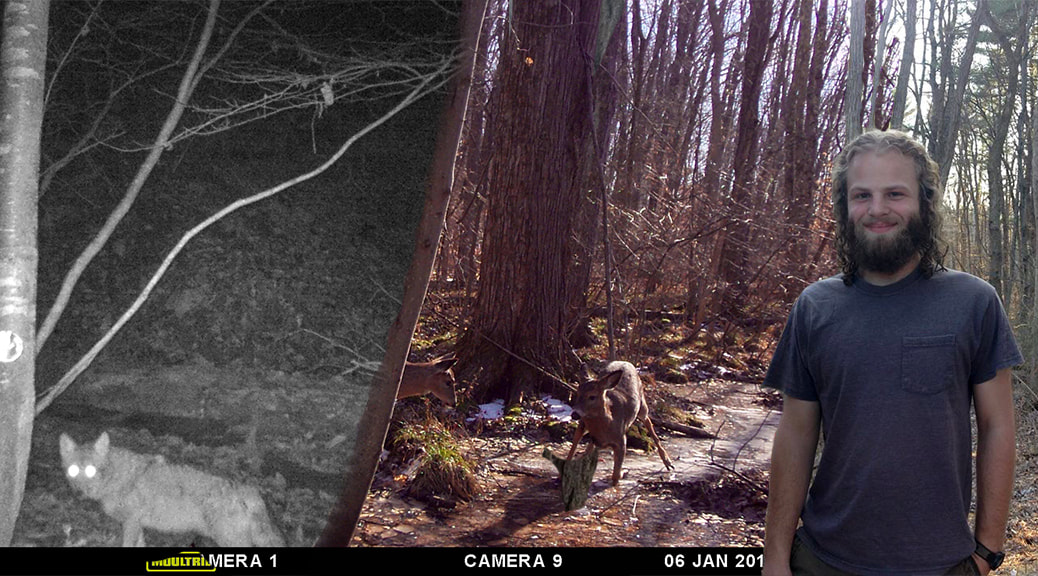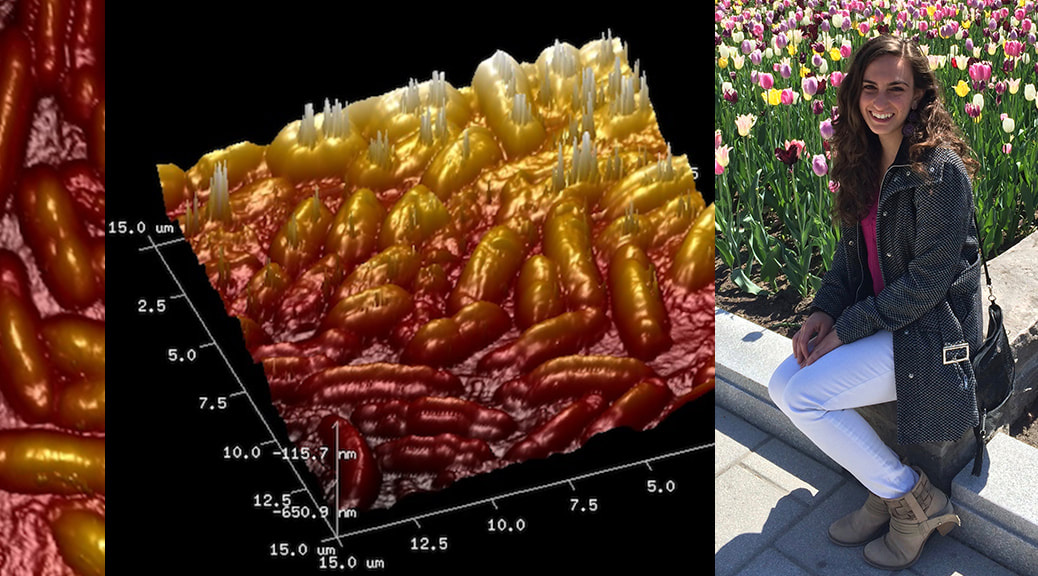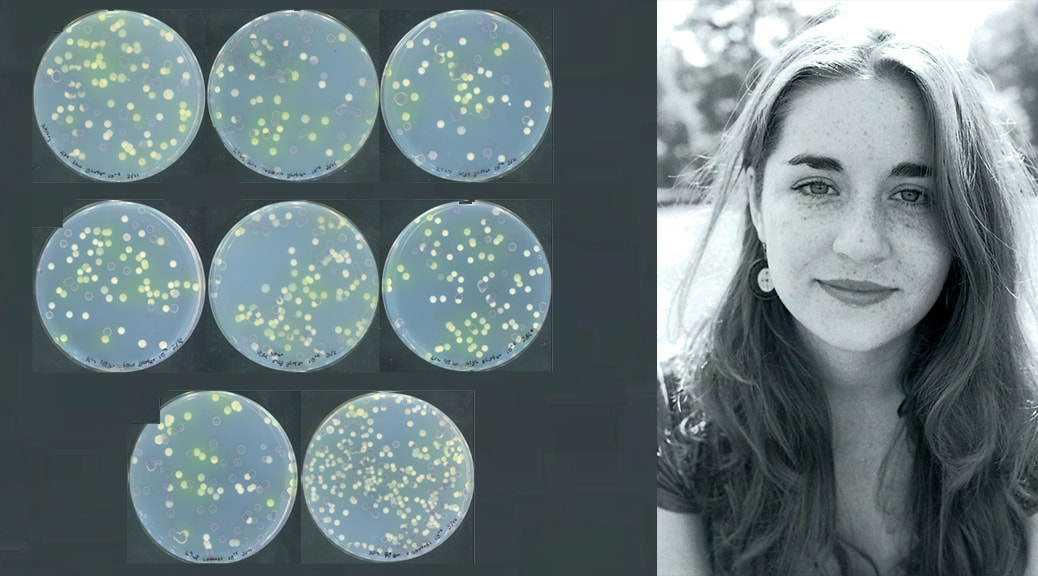Melissa Yost-Bido '19
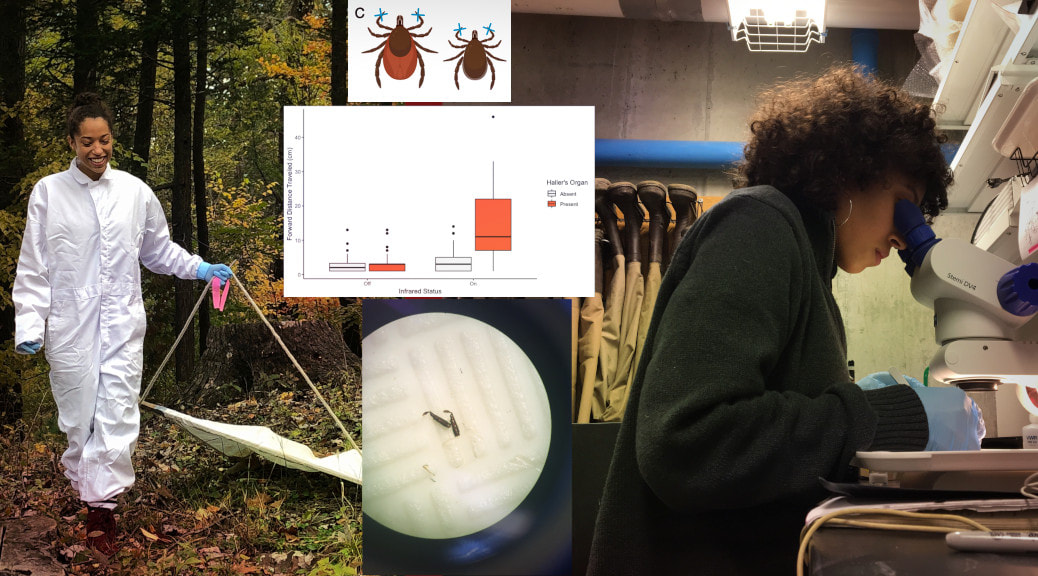
Ticks are vectors for several serious diseases (meaning that they can transmit these diseases to humans), including Lyme disease, babesiosis, and anaplasmosis. Melissa Yost-Bido ’19 studied something called Haller’s organs: chemosensory organs (essentially, a very special type of smell) that ticks have on their front legs, and that is thought to help them detect pheromones, carbon dioxide, and infrared radiation. As you can guess, all that ticks really care about, is how to find a host (such as a mouse, or a human), to attach to them, and feed on their blood. Being able to detect animal smells and heat would definitely help here!
Many methods of tick-borne disease prevention that are used now, harm not only ticks, but also other, good, beneficial organisms. If we learn more about the Haller’s organ, we can try to find new ways to fight ticks, by making sure that they cannot find new hosts. Melissa studied the ability of the Haller’s organ in blacklegged ticks (Ixodes scapularis; the nastiest ticks around here) to detect infrared light. She collected local ticks, separated them into groups, and then either left their Haller’s organs intact, or removed them. Then Melissa exposed each tick from each group to infrared light (heat), and recorded the distance that each tick moved towards the source of infrared radiation. She found that ticks with a Haller’s organ traveled farther towards the heat, compared to those that had their Haller’s organs removed. This suggests that Ixodes ticks can use Haller’s organs to detect warm bodies, which is something nobody had ever shown before!
Many methods of tick-borne disease prevention that are used now, harm not only ticks, but also other, good, beneficial organisms. If we learn more about the Haller’s organ, we can try to find new ways to fight ticks, by making sure that they cannot find new hosts. Melissa studied the ability of the Haller’s organ in blacklegged ticks (Ixodes scapularis; the nastiest ticks around here) to detect infrared light. She collected local ticks, separated them into groups, and then either left their Haller’s organs intact, or removed them. Then Melissa exposed each tick from each group to infrared light (heat), and recorded the distance that each tick moved towards the source of infrared radiation. She found that ticks with a Haller’s organ traveled farther towards the heat, compared to those that had their Haller’s organs removed. This suggests that Ixodes ticks can use Haller’s organs to detect warm bodies, which is something nobody had ever shown before!
Rachel Mendoza '19
We live in the era of antibiotic resistance: old, familiar antibiotics, that used to work so well in the past, are no longer guaranteed to kill harmful bacteria, as the bacteria evolve new ways to fight back and survive the treatment. Because of that, now, more than ever, it is important to study the fundamentals of gene regulation in bacteria, with a hope to find new ways to control them.
Riboswitches are a unique mechanism of gene regulation that is used by bacteria, fungi, and plants. A piece of RNA with a riboswitch changes its shape depending on what chemicals are present in the cell, which in turn changes what proteins are produced by the bacterium. Riboswitches were shown to be critical for the bacterial survival, which means that in the future, we can try to use them as targets for the development of new pharmaceuticals. With the guidance from Dr. Gabriel Perron and Dr. Swapan Jain, Rachael Mendoza ’19 used bioinformatic tools to identify and classify the riboswitches in thirty strains of a certain bacterial species (B. subtilis). She described the diversity of riboswitches in these strains, and put forth some interesting hypotheses about how this information can inform development of future medical treatments.
Riboswitches are a unique mechanism of gene regulation that is used by bacteria, fungi, and plants. A piece of RNA with a riboswitch changes its shape depending on what chemicals are present in the cell, which in turn changes what proteins are produced by the bacterium. Riboswitches were shown to be critical for the bacterial survival, which means that in the future, we can try to use them as targets for the development of new pharmaceuticals. With the guidance from Dr. Gabriel Perron and Dr. Swapan Jain, Rachael Mendoza ’19 used bioinformatic tools to identify and classify the riboswitches in thirty strains of a certain bacterial species (B. subtilis). She described the diversity of riboswitches in these strains, and put forth some interesting hypotheses about how this information can inform development of future medical treatments.
Lucy Christiana '19
For her senior project, Lucy Christiana ’19 built a computer simulation of plant community dynamics. Lucy studied how plants would grow if they experience a phenomenon called “plant-soil negative feedback”. Despite a scary name, the idea of this effect is rather simple: imagine that every growing plant is attacked by some “bad stuff” living in the soil, such as pathogenic fungi that try to weaken or kill the plant. As a plant is growing , these fungal pathogens will multiply in the soil around it, making this patch of soil kind of hostile to this plant species. Any seed from this species, for example, will have a hard time surviving in this particular patch of soil, just because it is so rich with “bad fungi”. A different plant species, however, will have no problem living there, as it will be immune to pathogens (each plant species comes with its own list of enemies, so pathogens of one species don’t necessarily harm the other).
As you can imagine, this can really change how plants grow, and it would probably improve biodiversity: even if one plant species is a strong competitor, it will soon be weakened by local pathogens, allowing other species to grow in its place. Lucy was interested in how these negative feedbacks shape the emerging plant community, and she used over 30 years of historical vegetation data from a particular long-term field experiment in Lawrence, Kansas. Lucy built a cellular automata model for one of the species described in this experiment (Ambrosia artemisiifolia, aka common ragweed), and compared predictions of her model to real data. This study is a step towards a more integrated analysis of spatiotemporal patterns of plant community assembly dynamics, and it can help us to understand how plants interact with each other, and how these interactions shape the landscapes that surround us.
As you can imagine, this can really change how plants grow, and it would probably improve biodiversity: even if one plant species is a strong competitor, it will soon be weakened by local pathogens, allowing other species to grow in its place. Lucy was interested in how these negative feedbacks shape the emerging plant community, and she used over 30 years of historical vegetation data from a particular long-term field experiment in Lawrence, Kansas. Lucy built a cellular automata model for one of the species described in this experiment (Ambrosia artemisiifolia, aka common ragweed), and compared predictions of her model to real data. This study is a step towards a more integrated analysis of spatiotemporal patterns of plant community assembly dynamics, and it can help us to understand how plants interact with each other, and how these interactions shape the landscapes that surround us.
Sarah Weiner '18
In recent years, many have speculated that climate change is the driving force behind the spike in cases of Lyme disease in the northeastern United States. It would be really useful for the public if we could use climate data to predict places and times at risk for Lyme disease. In her senior project, Sarah Weiner used public records from the United States Drought Monitor to create a climate index. Then, with guidance from professor Felicia Keesing, Sarah built statistical models to see whether this climate index could be used to predict year-to-year variation in Lyme disease incidence at the county level. Sarah found that climate is not a practical way to predict Lyme disease outbreaks, and that other factors, such as location, are much better predictors.
Biz Osborne-Schwartz '18
In her senior project, Biz Osborne-Schwartz’ 17 sought to improve oral rehydration therapies (ORT) for cholera patients. Working with her advisor, Professor Brooke Jude, Biz developed a protocol to study the attachment of Vibrio cholerae to chitin (a stand-in for a human intestinal cell) and other carbohydrates. This new protocol allowed her to test if adding a certain type of chemical compounds, called enzyme resistant carbohydrates, to ORT could decrease the number of bacteria in a patient infected with cholera. Biz observed a decrease in Vibrio cholerae attached to chitin beads when incubated in ORT with enzyme resistant starches, which means that more complex ORT are promising for cholera patients!
Molly McQuillan '17
Biology graduate Molly McQuillan '17 and professor Arseny Khakhalin coauthored a neuroscience paper from Molly's senior project. The paper was published in the prestigious life sciences journal eLife, and presents new research that explains how the developing brain learns to integrate simultaneous sensory cues—sound, touch, and visual—that would be ignored individually.
Read full press-release from Bard
Full citation: Truszkowski, Torrey LS, Oscar A. Carrillo, Julia Bleier, Carolina Ramirez-Vizcarrondo, Molly McQuillan, Christopher P. Truszkowski, Arseny S. Khakhalin, and Carlos D. Aizenman. “A cellular mechanism for inverse effectiveness in multisensory integration.” eLife 6 (2017): e25392.
Read full press-release from Bard
Full citation: Truszkowski, Torrey LS, Oscar A. Carrillo, Julia Bleier, Carolina Ramirez-Vizcarrondo, Molly McQuillan, Christopher P. Truszkowski, Arseny S. Khakhalin, and Carlos D. Aizenman. “A cellular mechanism for inverse effectiveness in multisensory integration.” eLife 6 (2017): e25392.
Martie Stothoff '17
For her senior project, Martie studied the behavioural response in captive common marmosets (Callithrix jacchus – the second smallest primate in the world) to the introduction of a novel foraging-enrichment device. In captivity, animals often become bored, depressed, or stressed, and enrichment is a way in which caretakers can improve the lives of captive animals. Compared to many other animals, monkeys are very smart, and therefore need even more stimulation to keep them physically and psychologically active. Knowing how to keep animals happy and healthy in captivity is a highly important aspect of conservation biology.
In the wild, marmosets don’t just collect fruits and insects like many other monkeys do, but gouge trees with their teeth and suck out the sap. In captivity however, most monkeys are fed fruits and vegetables from stationary bowls, which provides enough nutrition, but gives no practice in natural ways foraging, and makes the marmosets lose their ability to gouge trees. With the help of Bard professor Felicia Keesing, Martie designed a novel enrichment device for captive marmosets living in captivity in Costa Rica. The device was made of a small wooden log with holes drilled all around it, that Martie filled with honey and hang up vertically in the cages. This study was the first ever to try honey as a sap substitute for common marmosets, and Martie found that this simple device increased positive foraging behaviours and decreased inactivity, significantly improving the well-being of captive monkeys.
In the wild, marmosets don’t just collect fruits and insects like many other monkeys do, but gouge trees with their teeth and suck out the sap. In captivity however, most monkeys are fed fruits and vegetables from stationary bowls, which provides enough nutrition, but gives no practice in natural ways foraging, and makes the marmosets lose their ability to gouge trees. With the help of Bard professor Felicia Keesing, Martie designed a novel enrichment device for captive marmosets living in captivity in Costa Rica. The device was made of a small wooden log with holes drilled all around it, that Martie filled with honey and hang up vertically in the cages. This study was the first ever to try honey as a sap substitute for common marmosets, and Martie found that this simple device increased positive foraging behaviours and decreased inactivity, significantly improving the well-being of captive monkeys.
Shailab Shrestha '17
Shailab Shrestha studied how bacteria develop resistance against antimicrobial agents, such as antimicrobial peptides. Together with Prof. Gabriel Perron, Shailab sequenced genomes of several experimentally evolved Pseudomonas fluorescens populations resistant to high concentrations of a certain synthetically modified antimicrobial peptide named pexiganan, and compared these genomes to each other. The results of his original studies were not quite clear due to possible contamination, but Shailab followed up on them in 2016, and the project has high chances of being eventually published as research paper.
Devin Fraleigh '17
This amazing photo of a snow leopard (Panthera uncia) was taken by Bard biology senior Devin Fraleigh, who is now working with Panthera foundation, in collaboration with the American University of Central Asia in Kyrgzstan, to study populations of snow leopards in the Tien Shan mountains. This image of an adult leopard was captured using an automated camera in early March 2017 on a mountain pass in the Ala-Too mountain range, not far from Bishkek.
Daniella Azulai '17
In her senior project, Daniella Azulai ’17 studied antibiotic resistance of a bacterium Pseudomonas aeruginosa: a pathogen that plagues patients with compromised immune systems and people with cystic fibrosis. Daniella developed a new method to test how virulent (harmful) different strains of these bacteria are. Using larval zebrafish, she found that antibiotic resistance does not necessarily correlate with virulence, but rather that each strain showed a unique profile, pointing to differences in the evolution of these strains over time.
Sydney Pindling '16
Sydney Pindling finished her senior project in the fall of 2016, under the supervision of Professor Gabriel Perron. Sydney developed a promising new model to study the effects of antibiotics, such as streptomycin, on the animal microbiome. She exposed larval zebrafish (Danio rerio) to very low concentrations of streptomycin; in fact, the concentrations Sydney used were similar to those observed in in environment: rivers and streams near human settlements. Sydney found that that even at these low concentrations streptomycin changed the microbiome in the larval fish, and increased larval mortality. She also observed that the microbes in the fish gut were selected for genes associated with antibiotic resistance. These results may have relevance both for studies of antibiotic effects in humans, and for environmental research on fish populations.
Theo Black '16
Many aquatic insects use polarized light to find water surfaces on which they reproduce, and where their larvae live and grow. Manmade objects and structures can sometimes mimic these water surfaces by polarizing light. Moreover, in some cases they can be more attractive to aquatic insects than water itself. This effect causes “ecological traps” that can lead aquatic insects to population decline or even extinction.
Previous studies have shown that the attractiveness of polarizing synthetic surfaces can be reduced if grids of non-polarizing lines are strategically placed on them. In his senior project, Theodore Black measured the effect of line thickness on the attractiveness of polarizing non-water surfaces. Early in the morning he would install his polarizing traps near the water stream, and late at night he would collect them. Then, for days and days, he would sort and identify insects trapped in oil under the microscope, classifying them into such poetically named groups as non-biting midges (Chironomidae), black flies (Simulliidea), caddisflies (Trichoptera), and mayflies (Ephemeroptera). This work allowed Theo to analyze and describe the effect of non-polarizing line thickness on the attractiveness of traps, which will help to protect aquatic insects from human interference. Using this new information, engineers will be able to design solar panels that are efficient, yet don’t trick aquatic insects into laying eggs on it, helping them to avoid an evolutionary trap.
Previous studies have shown that the attractiveness of polarizing synthetic surfaces can be reduced if grids of non-polarizing lines are strategically placed on them. In his senior project, Theodore Black measured the effect of line thickness on the attractiveness of polarizing non-water surfaces. Early in the morning he would install his polarizing traps near the water stream, and late at night he would collect them. Then, for days and days, he would sort and identify insects trapped in oil under the microscope, classifying them into such poetically named groups as non-biting midges (Chironomidae), black flies (Simulliidea), caddisflies (Trichoptera), and mayflies (Ephemeroptera). This work allowed Theo to analyze and describe the effect of non-polarizing line thickness on the attractiveness of traps, which will help to protect aquatic insects from human interference. Using this new information, engineers will be able to design solar panels that are efficient, yet don’t trick aquatic insects into laying eggs on it, helping them to avoid an evolutionary trap.
David Hendler '16
David Hendler in interested in wildlife conservation. In his senior project he is trying to develop methodologies for surveying wildlife corridors in fragmented forest habitat. To study this question, David placed dozens of automatic wildlife cameras in the woods around the Town of Red Hook. Working under supervision of Professors Felicia Keesing and Bruce Robertson, he collected thousands of photographs of various mammals, and analyzed them, to check whether animal diversity is different in in wildlife corridors compared to the larger habitats they connect.
On a picture: a collage of several photos, one showing a coyote, and another one with some deer.
On a picture: a collage of several photos, one showing a coyote, and another one with some deer.
Alessia Zambrano '16
For her senior project, Alessia Zambrano characterized biofilms produced by a bacterium Janthinobacterium lividum: a strain isolated from the Hudson River Valley area that plays an essential role in aquatic health and community diversity. Alessia took three-dimensional images of the biofilm using an atomic force microscope. These 3D reconstructions for the first time provide a detailed picture of the shape, size, and surface topography of individual cells of this bacterial strain.
Katherine Moccia '16
In her senior project, Katherine Moccia studied potential effects hydraulic fracturing (aka fracking) can have on microbial communities in streams near fracking sites. Under supervision of prof. Brooke Jude, Katherine tried to understand whether the presence of bacteria that produce purple pigments, such as species of Janthinobacterium, can be used as an indicator for the overall “health” of a natural water stream. She used microbial isolates from a local creek, and added a commonly used hydraulic fracturing material called glutaraldehyde to simulated microbial communities, to quantify the effects glutaraldehyde would have on the number of purple colonies. The results of this project were not quite clear, but are promising methodologically.

